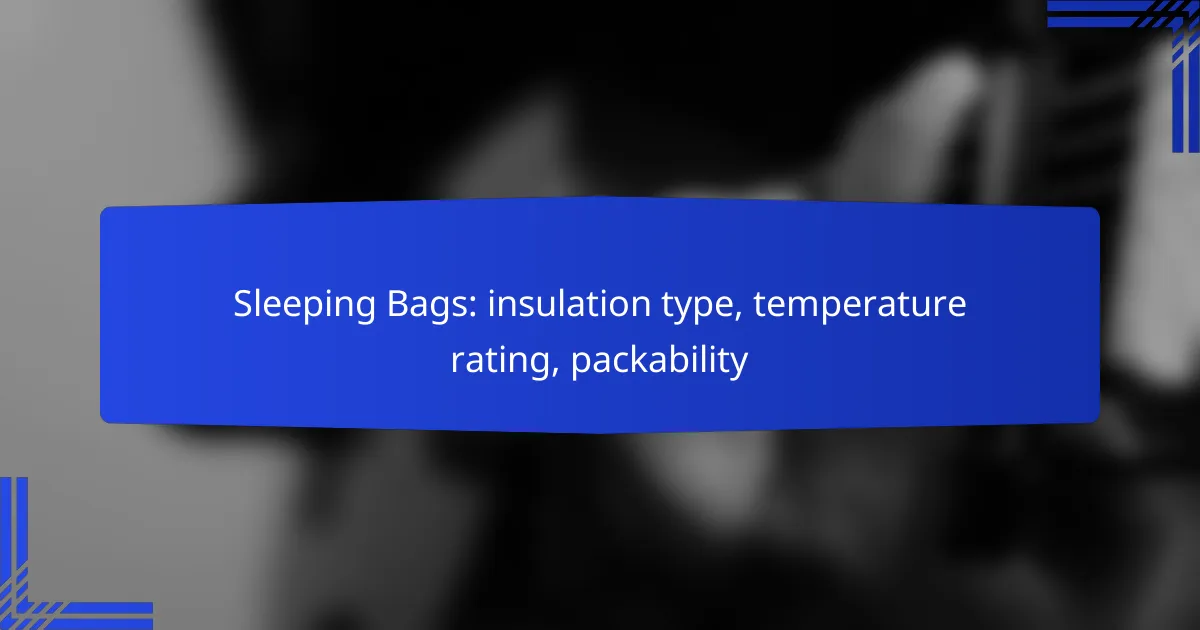Choosing the right sleeping bag is essential for outdoor adventures in New Zealand, where conditions can vary widely. Key factors to consider include insulation type, temperature rating, and packability, which together ensure warmth, comfort, and ease of transport. Selecting a bag that meets these criteria will enhance your experience, allowing you to enjoy the stunning landscapes without compromising on safety or convenience.

What are the best sleeping bags for New Zealand conditions?
The best sleeping bags for New Zealand conditions offer a balance of insulation type, temperature rating, and packability to handle the diverse climates. Look for bags that provide adequate warmth for cooler nights while being lightweight and compact for easy transport during outdoor adventures.
Therm-a-Rest Questar 20
The Therm-a-Rest Questar 20 is designed for three-season use, making it suitable for New Zealand’s variable weather. It features a down insulation that provides excellent warmth-to-weight ratio, ensuring you stay warm even in temperatures around -6°C.
This sleeping bag is highly packable, compressing down to a small size that fits easily in a backpack. Its unique design includes a draft collar and a draft tube, which help retain heat and prevent cold air from seeping in.
Sea to Summit Spark SpI
The Sea to Summit Spark SpI is an ultralight option ideal for summer or mild conditions in New Zealand. With a temperature rating of approximately 0°C, it uses high-quality down insulation that keeps the weight down while still providing warmth.
This bag is extremely compact, making it perfect for backpacking trips where space is limited. Its minimalist design includes a tapered shape that reduces bulk without sacrificing comfort, making it a favorite among weight-conscious hikers.
Big Agnes Lost Dog 15
The Big Agnes Lost Dog 15 is a versatile sleeping bag that performs well in colder conditions, with a temperature rating of about -9°C. It features synthetic insulation, which retains warmth even when damp, making it a practical choice for unpredictable New Zealand weather.
This bag is designed with a unique integrated sleeping pad sleeve, ensuring you stay comfortable and insulated from the ground. While it is slightly bulkier than down options, its durability and warmth make it a reliable choice for camping in various terrains.

How does insulation type affect sleeping bag performance?
The insulation type significantly influences a sleeping bag’s warmth, weight, and packability. Choosing the right insulation can enhance your comfort and performance during outdoor activities, especially in varying weather conditions.
Down insulation for warmth and compressibility
Down insulation is known for its excellent warmth-to-weight ratio, making it a popular choice for backpackers and campers. It compresses well, allowing for easy packing into small spaces, which is ideal for those who prioritize lightweight gear.
However, down insulation loses its insulating properties when wet, so it is best suited for dry conditions or when combined with a water-resistant shell. When selecting down sleeping bags, look for fill power ratings between 600 and 900, with higher numbers indicating better quality and insulation efficiency.
Synthetic insulation for moisture resistance
Synthetic insulation offers better moisture resistance compared to down, making it a reliable option for damp environments. It retains warmth even when wet, which is crucial for safety during unexpected weather changes.
While synthetic bags are generally heavier and bulkier than their down counterparts, they are often more affordable and easier to care for. When choosing synthetic insulation, consider options with a thermal efficiency rating that meets your expected temperature range, typically between 0°C to -10°C for three-season use.

What temperature ratings should I consider for camping in New Zealand?
When camping in New Zealand, consider temperature ratings that align with the seasonal conditions and your planned activities. Generally, sleeping bags are rated for specific temperature ranges, which help ensure comfort and safety during your outdoor adventures.
Three-season ratings for versatility
Three-season sleeping bags are designed for spring, summer, and autumn camping, typically rated between 0°C to 10°C. These bags provide a balance of warmth and packability, making them suitable for a variety of conditions in New Zealand’s temperate climate.
When choosing a three-season bag, look for features like down insulation for lightweight warmth or synthetic materials for moisture resistance. A bag with a temperature rating of around 5°C is often a good choice for versatility, allowing you to camp comfortably in most conditions.
Winter ratings for cold weather camping
For winter camping in New Zealand, opt for sleeping bags rated for temperatures below 0°C, ideally down to -10°C or lower. These bags are designed to retain heat in frigid conditions, providing essential insulation during colder nights.
When selecting a winter sleeping bag, consider factors such as insulation type and bag shape. Mummy-shaped bags tend to offer better heat retention, while synthetic insulation can perform well in damp conditions. Ensure your bag has a draft collar and hood to minimize heat loss, enhancing your comfort during chilly nights.

How does packability influence sleeping bag choice?
Packability is a crucial factor in selecting a sleeping bag, as it determines how easily the bag can be transported during outdoor activities. A more packable sleeping bag allows for efficient use of space in your backpack, making it easier to carry on long hikes or trips.
Compression size for backpacking
When backpacking, the compression size of a sleeping bag is essential for maximizing space. Look for bags that come with compression sacks, which can reduce the bag’s volume significantly, often by half or more. This feature is particularly beneficial for multi-day trips where every ounce and inch counts.
For example, a sleeping bag with a packed size of around 10 x 6 inches is generally manageable for backpacking, while larger bags may take up too much room. Always check the compression ratio to ensure it meets your packing needs.
Weight considerations for travel
Weight is another critical aspect when choosing a sleeping bag for travel. Ideally, aim for a bag that weighs between 1 to 3 pounds, depending on the insulation type and intended use. Lighter bags are preferable for long treks, while heavier options may offer more warmth but can be cumbersome.
Consider the trade-off between weight and insulation. Down sleeping bags tend to be lighter and more compressible than synthetic ones, making them a popular choice among serious backpackers. However, synthetic bags can still provide adequate warmth and are often more affordable, so weigh your options based on your travel style and budget.

What features should I look for in a sleeping bag?
When selecting a sleeping bag, focus on insulation type, temperature rating, and packability. These features will significantly impact your comfort and convenience during outdoor adventures.
Zipper types for ease of use
Zipper types can greatly affect the usability of a sleeping bag. Look for bags with two-way zippers that allow you to open the bag from either end, providing flexibility for ventilation and ease of entry. Some models also feature anti-snag designs to prevent the zipper from catching on the fabric.
Consider zippers with a draft tube, which helps to keep cold air from entering through the zipper area. This is particularly useful in colder climates where maintaining warmth is essential. A good zipper should be smooth and durable, ensuring it withstands repeated use.
Hood design for added warmth
The hood design of a sleeping bag plays a crucial role in retaining heat. A well-structured hood should fit snugly around your head while allowing for some adjustability. Look for features like drawstrings or Velcro closures that can help seal in warmth.
Some sleeping bags come with a contoured hood that wraps around your head, providing extra insulation. This is especially beneficial in colder temperatures, as it minimizes heat loss. A good hood design can make a significant difference in your overall comfort during chilly nights.

What are the top brands for sleeping bags in New Zealand?
In New Zealand, popular sleeping bag brands include Montbell and MSR, known for their lightweight options and durability, respectively. These brands cater to various outdoor needs, from casual camping to serious trekking.
Montbell for lightweight options
Montbell specializes in lightweight sleeping bags that are ideal for backpackers and hikers looking to minimize pack weight. Their designs often feature high-quality down insulation, which provides excellent warmth-to-weight ratios.
When choosing a Montbell sleeping bag, consider the temperature rating to ensure it meets your needs for the climate you’ll be in. Their bags typically pack down small, making them easy to carry on long treks.
MSR for durability
MSR (Mountain Safety Research) is renowned for producing durable sleeping bags that withstand rugged conditions. Their bags often incorporate synthetic insulation, which performs well in wet environments and offers good longevity.
For outdoor enthusiasts in New Zealand, MSR sleeping bags are a reliable choice for camping in diverse weather. Look for features like reinforced zippers and water-resistant fabrics to enhance durability and performance in the field.

How do I maintain my sleeping bag for longevity?
To maintain your sleeping bag for longevity, regular cleaning and proper storage are essential. Following the manufacturer’s care instructions can help preserve insulation and fabric integrity, ensuring your bag remains functional for many camping trips.
Proper washing techniques
Washing your sleeping bag correctly is crucial to maintaining its insulation and overall condition. Use a front-loading washing machine on a gentle cycle with cold water and a mild detergent specifically designed for down or synthetic materials. Avoid using bleach or fabric softeners, as they can damage the fibers.
After washing, it’s important to rinse thoroughly to remove all detergent residues. Consider adding a couple of clean tennis balls to the dryer when drying your bag; this helps fluff the insulation and restore its loft. Dry on a low heat setting, checking periodically to prevent overheating.
